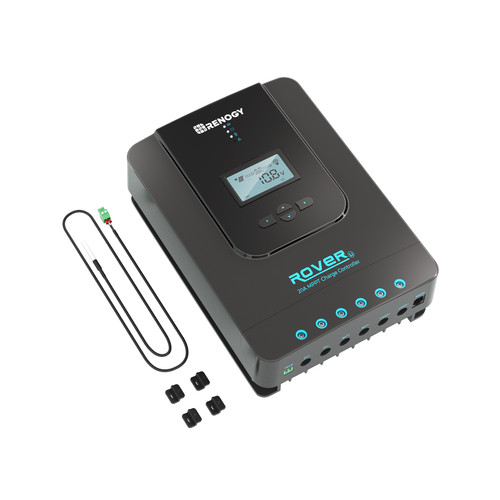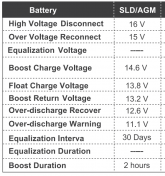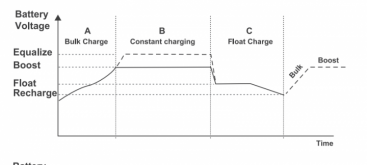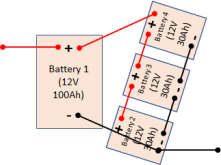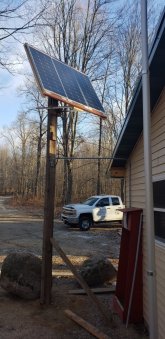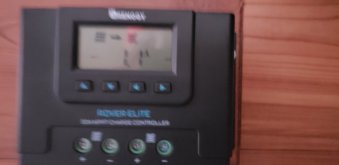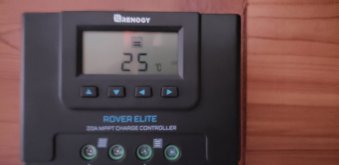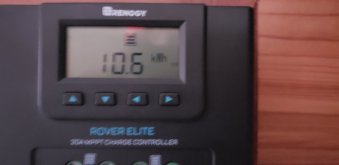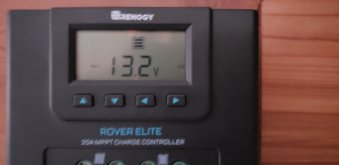HARG Hunter
Thirsty for Off-Grid Knowledge
I continue to build my system and make adjustments as I go.
Looking for advice on setting up my battery bank to fit best with the rest of my system.
Current Set-Up:
*300 watts of panels (3 - 100 Watt Renogy Panels in parallel) 21.6 VOC
*Renogy Rover Elite 20A MPPT Charge Controller
*Battery Bank: (1) Universal Power 100ah AGM, (3) Mighty Max 30ah AGM (Wired in parallel)
*Stanley 1000 watt Modified Inverter (I know I need to upgrade this for sure)
*The most we expect to use is approx 1200-1300 watts per day, so our system is a little short right now but close to being up to the task.
We are in a wooded area where the panels only get 3-4 hours of really solid sun. I've taken down most trees, but I do get small bits of shade across the array occasionally which is why I have them in parallel instead of series. I may buy a 4th panel and go 2p2s with them to send more to the charge controller.
I've read in a few places that wiring more than 3 batteries in parallel isn't good as there is some loss there. Thoughts?
If I decide to go with 2s2p (Bringing me to a 24v system), is it OK that I have 1 at 100ah and the others at 30ah each, or do I need to balance the battery bank out somehow?
If I do go that direction, I would most likely add 1 panel, add 1 battery (100ah), upgrade to a 30a or 40a controller and go to a 1000-1200 watt Pure Sine Inverter.
That would give me this system:
*400w in Panels (2s2p)
*30a MPPT Controller
*130 ah in Batteries (100ah+30ah in parallel wired in series with another 100ah+30ah in parallel) Gives me 24v/130ah correct?
I know I've posted a lot of stuff in different areas of the forum.
The reason I'm posting it here is my main concern that my current configuration of batteries is hurting my system.
I've got 100ah+30ah+30ah+30ah wired in parallel at the moment.
Idea was that if we need approx. 1200 watts per day, this bank would come to close to giving us that (190ah total, with 95ah usable giving us 1140 of usable wattage).
I do have a constrained budget. In the end, I'll spend what I have to, to get the system where it needs to be. Hoping for some advice on how to get this system to where it needs to be piece by piece. I can't buy what I need to upgrade everything right away.
OK - Tear it apart and give me your opinions!
Looking for advice on setting up my battery bank to fit best with the rest of my system.
Current Set-Up:
*300 watts of panels (3 - 100 Watt Renogy Panels in parallel) 21.6 VOC
*Renogy Rover Elite 20A MPPT Charge Controller
*Battery Bank: (1) Universal Power 100ah AGM, (3) Mighty Max 30ah AGM (Wired in parallel)
*Stanley 1000 watt Modified Inverter (I know I need to upgrade this for sure)
*The most we expect to use is approx 1200-1300 watts per day, so our system is a little short right now but close to being up to the task.
We are in a wooded area where the panels only get 3-4 hours of really solid sun. I've taken down most trees, but I do get small bits of shade across the array occasionally which is why I have them in parallel instead of series. I may buy a 4th panel and go 2p2s with them to send more to the charge controller.
I've read in a few places that wiring more than 3 batteries in parallel isn't good as there is some loss there. Thoughts?
If I decide to go with 2s2p (Bringing me to a 24v system), is it OK that I have 1 at 100ah and the others at 30ah each, or do I need to balance the battery bank out somehow?
If I do go that direction, I would most likely add 1 panel, add 1 battery (100ah), upgrade to a 30a or 40a controller and go to a 1000-1200 watt Pure Sine Inverter.
That would give me this system:
*400w in Panels (2s2p)
*30a MPPT Controller
*130 ah in Batteries (100ah+30ah in parallel wired in series with another 100ah+30ah in parallel) Gives me 24v/130ah correct?
I know I've posted a lot of stuff in different areas of the forum.
The reason I'm posting it here is my main concern that my current configuration of batteries is hurting my system.
I've got 100ah+30ah+30ah+30ah wired in parallel at the moment.
Idea was that if we need approx. 1200 watts per day, this bank would come to close to giving us that (190ah total, with 95ah usable giving us 1140 of usable wattage).
I do have a constrained budget. In the end, I'll spend what I have to, to get the system where it needs to be. Hoping for some advice on how to get this system to where it needs to be piece by piece. I can't buy what I need to upgrade everything right away.
OK - Tear it apart and give me your opinions!



